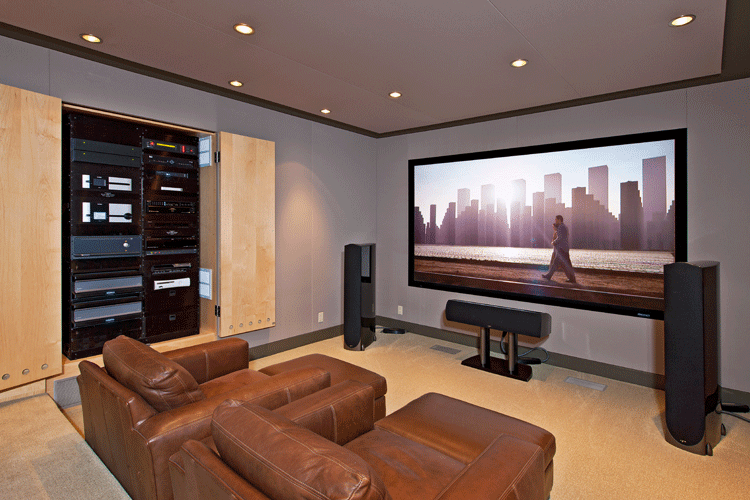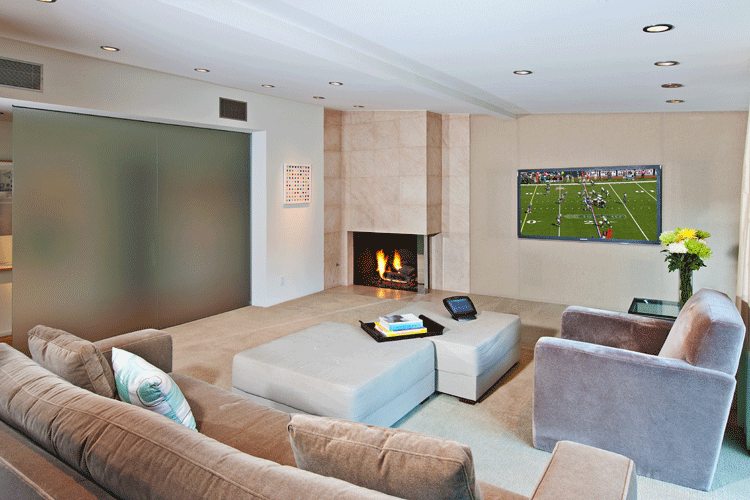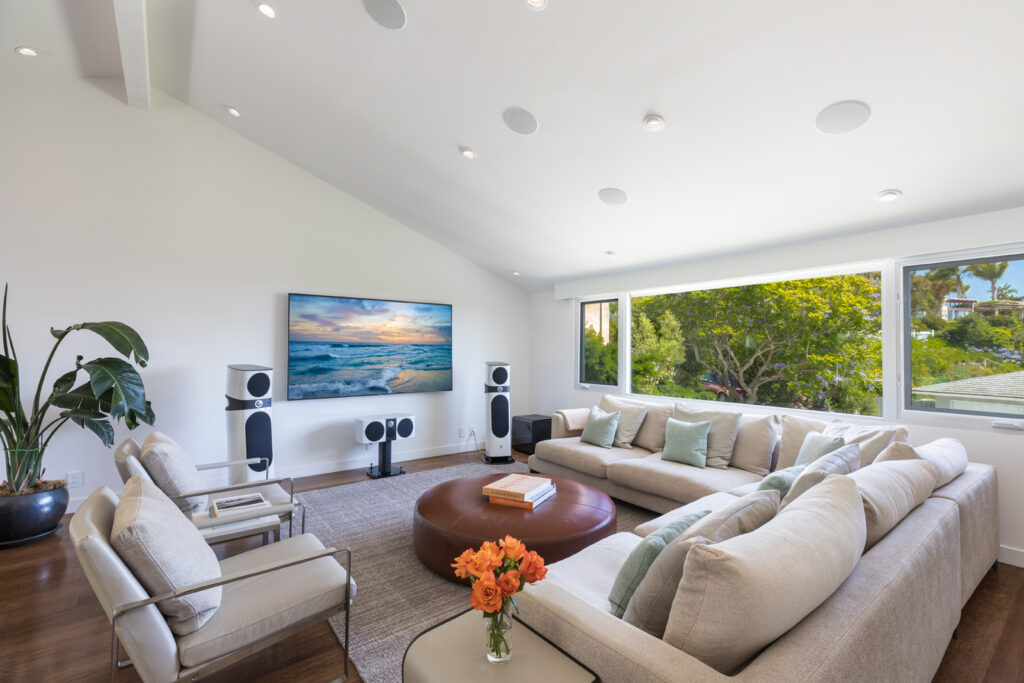When you think about it, audiophiles and home theater enthusiasts should really have a lot in common. Any good home theater starts with great sound reproduction, and audiophile gear is all about producing studio-quality audio. The surround sound part of a home theater is just a complex expansion of good stereo imaging and depth to make movie soundtracks (and other media like TV and beyond) sound more engaging. With YouTube.com taking over for MTV in the modern era for the world of music videos and so much more, one would think that having a video monitor as part of your system would be a no-brainer. It isn’t. Audiophiles tend to hate video monitors, thinking that a reflective surface between their best speakers is more of a downside than watching the best art being made today (streaming television) on a lesser AV system.
Traditional audio enthusiasts can be very strict with their rules, and impose a “you can’t be in the club” potential outcomes, even if our hobby standards are quite out of step with the mainstream world. For example, video gaming is a bigger business than all of Hollywood movies and music combined. Video gaming has young kids (of all genders and a very young demographic) investing in tech like $300 ultra-light, carbon fiber mice, fiber optic keyboards, high-refresh rate monitors and Cray super-computer-like PCs to run their increasingly realistic and fantastic game titles. Can you name me one audiophile salon that embraces video gaming in a meaningful way? Perhaps Best Buy, as they sell high-performance gaming systems from makers like Razer and Alien Ware, but they are hardly an audiophile salon.

Home Theater Products Are Now White Goods, Thus Carry Little Long-Term Retained Value
There are some AV industry pundits that blame William Wang of Vizio for ruining the home theater business. He brough ultra-low profit margins to the world of video monitor displays, and sold them through new, effective but soulless distribution channels that unquestionably took the “specialty” out of specialty AV. When plasma TVs originally hit the market, they were both expensive and relatively profitable by historical standards for the video business. Today, a reasonably-priced HDTV in a meaningful size (55-, 65-inch or larger) can be purchased at Costco for a few hundred bucks so that you can come home with a new 4K UHD window on the world, along with a 36 pack of Quilted Northern and a few pounds of crab claws. What will that TV (or the matching soundbar, etc. …) be worth in five years? Likely, it won’t be worth a penny at that late date.
Audiophile components retain their value much better, both historically and in modern times. A good pair of floorstanding speakers is a good pair of speakers, and that doesn’t change in terms of value, often for a long period of time. A solidly built, audiophile-grade integrated amp is often worth close to half of its value years and years after it was originally sold. Even formerly volatile audiophile categories like audiophile DACs and other digital components have stabilized. What does a BlueSound Node not do in terms of music management and streaming, while priced at a mere $499? Today’s DAC chipsets are increasingly able to accept software and firmware updates that allow these fast-changing components to say bleeding-edge in terms of performance, thus retain more and more value. AV products also have firmware and software updates, but somehow the feature set of a home theater component doesn’t stay relevant over time.
Simply put, your AV money is safer investing in audiophile gear than in home theater or video.

Audiophile Systems Are Simpler in an Often Overly-Complex World
As a Gen Xer whose first trip to Manhattan at nine years old was to buy a first-generation Compact Disc Player with my stepfather, and his work buddy and Rutgers University donor Bob Mortensen. The trip was mind-bendingly awesome. Philadelphia, my hometown, is without question a big city, but Manhattan’s energy was a whole other thing, especially to this young kid. Both Bob and my stepfather came home with pretty expensive $1,000 Denon Compact Disc players, and a few discs that were priced at close to $30 each. Ouch, but this level of access to “perfect sound forever” set me on a path where many of my younger years saw me invest tens of thousands of dollars in Compact Discs. I was just the right age to not delve into LPs, as this was about the exact tipping point in the switchover from LP to CD.
Roll the tape forward to today, and vinyl’s comeback is well-documented, even if the record 2022 RIAA sales numbers show that all physical media (all CDs and all LPs combined) made up about eight to nine percent of all music sales. Today, what draws younger people to owning an audiophile turntable is the idea that there is a certain simplicity and authenticity to the ritual of playing an LP. A vinyl record is unapologetically analog, and that is a very good thing in an overly digital world filled with phones, blue screens and beyond. The cover art on an album is big (compared to a small and plasticy Compact Disc) and the liner notes are an old-school way to learn about the artist, the music and more. The process of playing back an LP is a return to the concept of the album where using “shuffle” isn’t as relevant anymore. Younger listeners are drawn to listening to the legacy music that they love, on the format that it was designed to be played back on. This is what this audience is talking about when it comes to authenticity, and that is an important factor as to why someone enjoys art such as modern music playback.

Home Theater’s Technological Advances Made Systems Almost Too Good for the Money
Most modern HDTVs today reproduce a video picture that is SMPTE broadcast standard-ready, which is a huge technological advance. Simply, pull out the remote and select “picture” and choose whatever option seems (or sounds) like “cinema” or “theater.” Today, you are 99 percent of the way to broadcast quality, calibrated video that 20 years ago required a special guru to come to your home and tweak your TV to the bejesus. I used to pay “friend rates” per $500 television to get this level of video calibration work done back in the day and, when I owned a leading home theater online magazine. Projectors, and God knows that I’ve owned my fair share of those, it was much more expensive. Now, I can get better and brighter performance from a cheap, modern TV with about eight seconds of effort to press three buttons on the TV’s remote. That’s progress, but it also is a living example of how to take the “special” out of specialty AV, which has taken some of the enthusiasm out of the enthusiast side of the home theater hobby. Conversely, the need for acoustic consultants and turntable setup gurus still leaves a lot of hobby left in the world of audiophile.
Today’s home theater source components cost close to nothing, be it a silver disc player or a streamer like a Roku, an Apple TV, or even a Sonos Port. Seriously, those components can be had for barely three figures (or less), but in many cases are technically irrelevant, because many of today’s video monitors, which are at the core of any good home theater setup, actually include perfectly functional 4K content streaming right in their menus. No dongle or additional component is needed. Satellite TV services like DirecTV are expensive, but no longer need a dish to pipe content into your TV. Your WiFi connection does that (and lots more) inside of your low-cost, large-bright-thin-awesome HDTV monitor.

Today’s Hollywood Movies Aren’t as Good as They Used To Be
An audiophile will listen to one of his or her favorite albums over and over again for decades on end. How many of even the best movies can you say that about, and how many of those movies have been released recently? Hollywood has struggled with writers’ and actors’ strikes and other external factors – mainly the rise of streaming platforms that pay the writers, directors and talent the type of money that was historically only available in film. Gone is the stigma that the best talent only works in film. Jennifer Aniston works for Apple+ for her latest show, and she is as A-List as they come. Kate Winslet just did an amazing job (Emmy, anyone?) with an absolutely fantastic streaming series, The Regime. Brian Cranston highlighted his career’s best work on AMC, and now works on streaming, as he gets major accolades. The examples are endless, as the best creative content is not in music or film, as it had been for decades before. The best content is being created for streaming services in 4K.
So, if the new-school streaming content is so good (even if movies are meh), what’s the problem with a home theater? First off, there’s absolutely nothing wrong with owning a home theater. The issue is that, as very large HDTVs became more and more affordable, and the 4K object-based-surround-sound content to feed these sets is available to anybody with a WiFi connection and a credit card, even the most basic TV setup makes a pretty compelling experience. A friend of mine who will go unnamed, because he owns an AV company, just bought a 77-inch LG OLED TV (inky blacks and brighter than any plasma ever) with a few Sonos speakers and wireless subs. This simplistic system is nothing short of amazing. For a few grand, he has perhaps the best TV money can buy, and sound that is dynamic, accurate and full-range to go with it. Basically, there just isn’t that much hobby left in home theater, because the cheap stuff is not just good, but it is so damn affordable.
Will Audiophiles and Home Theater Enthusiasts Ever Get Along?
The demographic changes for the audiophile hobby are well-documented on the pages of FutureAudiophile.com, as that’s our raison d’etre around here. The old-school audiophiles are likely never going to embrace video (and certainly not video gaming) for their audiophile rigs, but that’s not the end of the world. The next generation of audiophiles has a different outlook on these respective hobbies. The idea that it is somehow like 1988, and that VHS machines can change the world with a rented movie, is simply antiquated. The reality is that you can bark commands at your phone (or any number of other voice-activated devices) and call up any/every movie ever made like you are Dick Tracy with a fancy new watch. You also no longer need to own movies on home video formats like DVD-Video or Blu-Ray as, today, better 4K content can be streamed on a per-viewing basis for a few bucks. Last night, we watched the latest James Bond movie from 2021 for $4. There’s a reason why Amazon bought MGM. It isn’t because movie theaters are where the future is – it is because content is where the future is. You know who learned the lesson from the other side of the equation? That would be Wall Street. Look at the money that they are pouring into buying classic rock music publishing. Queen’s catalog went for over a billion U.S. dollars. Bob Dylan, Bob Marley and Fleetwood Mac are only a few of the others to cash out of very valuable music songwriting catalogs.
Final Thoughts on the Age-old Debate About Home Theater Versus the Audiophile Hobby …
The lesson here is that content is always king. Technology has radically changed the way that we consume music, movies, television, gaming and other media. Audiophiles of the future (aka: our core audience) need to embrace modern ways to get the best, most HD content into their systems, and that might just someday include a video monitor. The home theater enthusiasts of the world aren’t likely to be growing in large numbers, because you just don’t need a big-dollar, tweaked-out home theater system to enjoy the best Hollywood blockbusters, streaming TV series or even Steely Dan Aja.
With more real-world access to the best of both worlds, our job as technological ambassadors for our friends, neighbors and family is to show them just how great a simple AV system can be, and how reasonable the prices can be. Life is better with access to vast amounts of music. Life is better being able to watch an Oscar-nominated film without having to go to a sticky-floor cineplex before Hollywood’s biggest day.
It is a good time to be into audio, as well as home theater. As divided as this nation can be at times on so many important topics, perhaps it is time to put down our arms in the battle between home theater and audiophile systems? Both have their advantages, and both can use the best elements to be integrated into one’s respective pride and joy systems. That’s a guaranteed win, no matter how you look at it, and there is no shame in mixing some of the best of both worlds into your system.
How do you look at the separation of church and state when it comes to audio and home theater? In your system(s), how do you deal with audio and video? Are they in separate rooms? Are your best audiophile components part of a surround sound system? Share with us where you stand on these topics below in our moderated comments.




Well said. Great video experience is so compact and reasonable and quality ultra-high for the money that anyone can have their theater. I think you take the smartest approach towards BOTH. I like your pics that show a good amalgam of both worlds.
Ideally, if I had a bit more lateral space right now, I’d like to provide better video support for my 2.2 channel rig as I am satisfied with my audio-focused sound. I have that with a laptop and a smaller screen, but a wall mount would work wonders allowing freedom for video. I’m just too afraid to move my system after working so hard to get the sound right with planars and subs. (I deserve a medal.. lol.)
There are times in my life I want some basic color visuals when I’m not actively listening or relegating the stereo to background music on the couch. And I think compromises should be made for more than one listener, even if the sound with canted-in planar speakers isn’t perfect for movie watching for the side seats. I view my needs as hybrid.
I am also a pretty hardcore console gamer and that whole headphone ecosystem is really another whole bird to fry. Or more of three birds to fry in one pot. Even in my mid-50’s, I am every bit a kid. These game-art forms are every bit as valid as their film counterparts.
In fact, more so when one watches Last of Us and then plays the game. The latter eclipses the TV show in drama, cinematics, action, etc. The same will hold true as technology changes- Video games require complete involvement from you as viewer- and the protagonist!
OH, and I just bought the Audeze Maxwells from Audeze on sale. Thanks!
NICE.
I have a pair next to my desk. My 12 year old wants them VERY BADLY
One Of a Few?